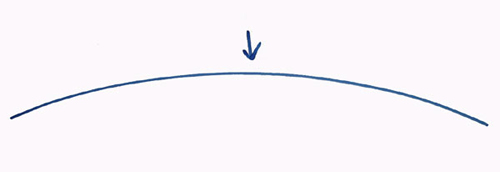Walking Revisited 
Good news: The Ministry of Walks in London has just approved our grant application! Funds are on the way, and we'll be able to continue our walking research—so let's get cracking!
We'll begin with a quick review: A social tango dancer’s job is to move with the music. That usually means expressing the compás (cadence) with the feet, and the rest of the music with movements of the upper body. We looked at specific examples of how good dancers express the compás with their feet on page 20, and on the previous page we looked at ways of following the full sound of the orchestra with the upper bodies by moving around the floor, and by turning. Now let’s look at the final mode of expression: Up and down movement.
We've seen how stepping onto a straight leg, and moving through the step without bending the knee creates a natural rise and fall. Continually click the right arrow above the image to review it:

This is the path our chest would follow with each step.
The body rises over an arc, with the heels passing at the arrow.

Here is how a series of steps (a walk) would look. The low points are where
the foot strikes the floor on the strong beat of the music, and the highest
points are when the couple stands tall on the weak beat.

This is how the walk begins after a pause: The couple stands tall, and then
the man tips forward into the first step. This causes the chest and
the embrace to drop forward, and down.
It's not always easy to see in the real world, but we'll try to isolate an example of Milonguero X tipping out of a pause, into a step. Here it is first in slow motion:
Tipping forward into the step from a straight leg.
And here it is in real time, with the music:
Notice how X's forward motion matches Troilo's music.
You can see how he tips forward into the step. His upper body goes first, carrying his partner along, and then his foot follows. Troilo's version of La Maleva in this video isn't really as staccato or picado (using abrupt or short notes) as Biaggi's version—but it's not a soft, instrumental tango either. It's in-between music with a kind of flowing, forward energy, and it matches well with the way X tips forward into the step. But there's more than one way of stepping.
The Advanced Class: Stepping II
What would happen if somewhere around the heel pass position, we flexed our supporting leg slightly, and then pushed off to finish the step? Well, the leg bend would cause us to drop a little lower—and by pushing off, we'd step a bit farther. And since we stepped farther, our legs would be farther apart, so we'd sink even lower—and finally, we'd have farther to come back up. The result would be a longer step, with the body dropping down more until the foot contacted the floor, and then rising farther back to the heel together position.
Here's the path our chest would follow with no leg bend:
And this is the kind of curve we'd have with some leg flex added near the high point of the arc. The result is a slightly longer step, with a longer swoop through the valley:
The following picture series shows how the end of the step would look. We begin on a straight leg, and then a little leg bend creates a "swoop" at the finish:
The last two images reveal that while we bend the supporting leg during the last part of the step, we still land on, a straight leg—and we continue to maintain a straight leg through the first part of the next step. This is important, because we express the strong beat of the compás not only by dropping down to the foot strike, but also by rising back up. It is both movements; both the fall and the rise of the partners' bodies, that expresses the compás. Flexing the leg at the beginning of the step tends to flatten out our walk, and some of the natural rhythm of the step is lost.
This may all sound technical and picky, but it might be worth studying—because when it's done well, the result is one of the nicest steps in tango:
Should I Learn This?
Maybe. When it's done right, intentionally flexing the leg is an additional tool for musical expression. It gives you a way to emphasize part of the music by adding more up and down movement, and it can also lengthen your step. But a lot of things can go wrong—in fact, a lot more things can go wrong than right. Most people bend their legs naturally when they walk, but in tango, if it's not done in a disciplined way, the result will be the kind of sloppy movement that can take the tango out of your dancing. Tango is listening and answering to the music by moving in a "tango-like" way. Nothing is more unattractive than watching people who don't know how to stand or step doing patterns and acrobatic figures all over the floor.
On the next page we'll take a look at the step again, and break down the movement a little more.

